#topologist
Note
Question for the Numbertaker: This may sound like a weird question, but are you actually human? Or are you some other creature that's just always in a human form? If you are human, then how did you become a Meanie? (I'm sorry if you're confused.)

Sorry if the image is a bit fuzzy - I don't know what happened there.
Wow deep lore moment
Not even lore just ridiculously wild headcanons because technically I can't answer with anything canon because there is no canon answer! So have this lol
Yeah, I'm pretty sure he isn't really human - his Meanie form was just so unstable when he was born that they had to keep him in his human form permanently!
#numberjacks#digital art#numbertaker#meanie form#human form#conceptmese topology#greekjetec xi#xi#topologist#the topologists are the technicians back where technically all the cast are from#which technically makes shaper a technician as she is a topologist too#she just doesn't know that#she doesn't know that her actual name is#conceptjack topology#headcanons really goin wild down here in the tags#lol
11 notes
·
View notes
Text
why is it called nine circles if it's entirely rectangles diamonds and polyminoes
4 notes
·
View notes
Text
I am a topologist if and only if it's funnier for me to be a topologist at that moment.
4 notes
·
View notes
Text
“imagine a symplectic manifold – and if you don’t know what a symplectic manifold is, just imagine a projective variety, that’s good enough”
#i am assuming that most of the people in this talk are symplectic geometers or topologists of some kind???#so this strikes me as a very funny comment to make#poast.txt
18 notes
·
View notes
Text
It is pleasing that the very closely related notions of closure, completion, and compactification all start with the same letter
5 notes
·
View notes
Video
The solution to this sewing/topology puzzle (”How do I sew this inside-out, so that when I turn it rightside-out, it’s a bag?”).
Hint: it’s a tube, so treat it like a tube.
#math#topology#sewing#inside-out#rightside-out#topology puzzle#sewing puzzle#hand sewing#hand stitched#project bag#sewing WIP#sewing problems#geometry problem#topology problem#sewists are secretly topologists#maybe math humour#ya dumdum#sewing topology
1 note
·
View note
Text
Math
Geologist: I do more math than you might think
Chemist: I mean, chemical equations are basically mathematical equations. If you think about it (I also do math math)
Physicist: Oh, yeah, it’s all math but we just handwave it
Mathematician: YOU DO WHAT!?
Quantum Physicist: *regularly does math that is literally beyond human comprehension* *now resides in a higher plane of existence*
Engineer: If I don’t do this math correctly PEOPLE WILL DIE
Military Scientist: If I don’t do this math correctly PEOPLE WILL SURVIVE
Topologist: If I don’t do this math correctly PEOPLE WILL BE MOSTLY UNAFFECTED
Philosopher: But what even IS math, really? No seriously, what is it?
Organic Chemist: I kinda forgot how to do math, to be honest
Biologist: I literally only chose this field so I wouldn’t have to do as much math. I love stamp collecting
Biostatistician: wtf
#science#biology#physics#chemistry#geology#scientists sitcom#why tf do I need a calculus credit for a bachelors of biology degree???#astronomy#engineering#math#military science#topology#biostatistics
1K notes
·
View notes
Photo
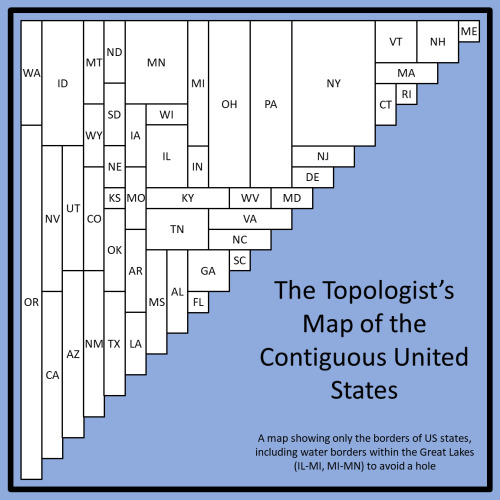
A topologist map of the US showing all state borders
827 notes
·
View notes
Text
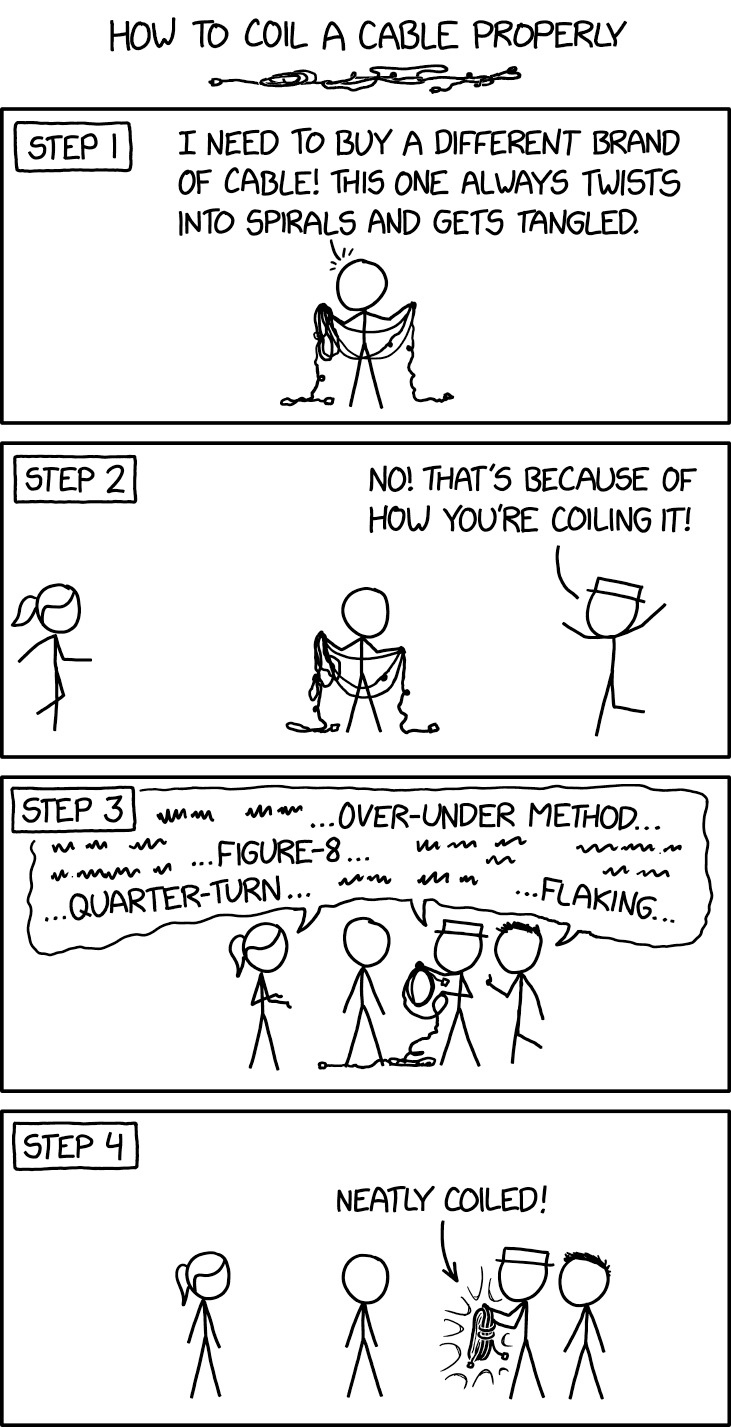
The ideal mix for maximum competitive cable-coiling energy is one A/V tech, one rock climber, one sailor, and one topologist.
How to Coil a Cable [Explained]
769 notes
·
View notes
Text
*runs excitedly into a mathematics lecture* i want to be a topologist! *20 minutes later* i think i was misinformed as to what your job entailed
1K notes
·
View notes
Text
topologists HATE her! local woman convinced that shirts only have 2 holes
#been giving this a lot of thought and honestly at this point u can’t change my mind on this sorry#o
480 notes
·
View notes
Text
Topological Spaces 2: Topologies and Continuity
Welcome to the second post in my introductory series to topology! The goal today is to give the definition of both topological spaces and continuous maps between them. These definitions will be very familiar from the last post so I highly recommend reading it here.
I do make brief reference to some constructions from linear algebra and abstract algebra however these aren't necessary for understanding the post. They are merely inserted for futher emphasis for those who are familiar.
2.1: Topological Spaces
In the last post, we saw that open sets are potentially a structure that we wish to study. Our definition will be in terms of properties we wish open sets to have without invoking any notion of a distance between point. Fortunately, open sets in metric spaces have properties which fit this exactly in the form of Lemma 1.11. We shall use these to give our definition of a topological space!
Definition 2.1:

Remarks:
We can show by induction that finite intersections of open sets are open. This property is equivalent to (T3), but (T3) is usually an easier property to check.
We can have different topologies on the same set as we shall see in the examples!
Examples 2.2:
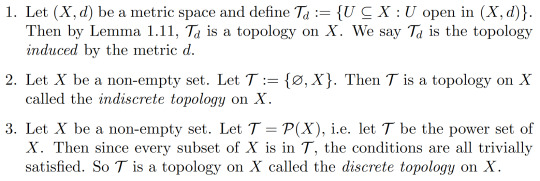
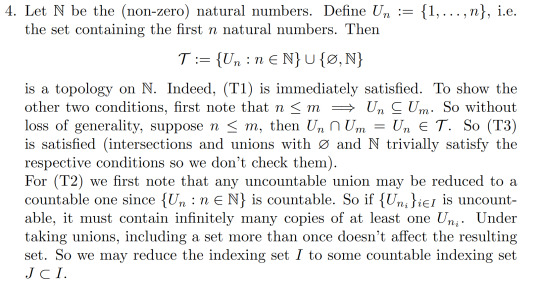


Remarks:
The topology on ℝ induced by the absolute value metric is called the standard topology on ℝ. Similarly, The topology induced by the Euclidean norm on ℝⁿ is called the standard topology on ℝⁿ.
The discrete topology is actually the same topology as the topology induced by the discrete metric. The proof involves showing that every singleton set (set that contains one element) is open in X with the discrete metric. Then use Lemma 1.11 to conclude that every set is open in X with the discrete metric.
Just like how some metrics can't be realised as the metric induced by a norm (and how some norms can't be realised as the norm induced by an inner product), not all topologies can be realised as the topology induced by a metric. A topology which can realised as the topology induced by a metric is called metrizable. The area of study dedicated to classifying metrizable spaces is called metrization theory and is very rich (and very much beyond the scope of these posts)
Both the indiscrete topology and the topology in 4) are non-metrizable. We shall see a proof of this in a future post.
One thing we may want to do is to make new topological spaces out of old ones. We don't yet have enough theory developed to do much but one easy construction we may do is putting a topology on subsets of our topology space:
Proposition 2.3:


2.2 Continuous Maps:
Now we have defined what a topology is, we may finally generalise the notion of continuity! Our guide will be Lemma 1.12.
Definition 2.4:

Remarks:
Continuity very much depends on the topology.
This really is a generalisation of continuity since Lemma 1.12 says that for metric spaces this notion is equivalent to our ε-δ definition (Definition 1.3)
We shall now see some examples in the form of the following proposition:
Proposition 2.5:
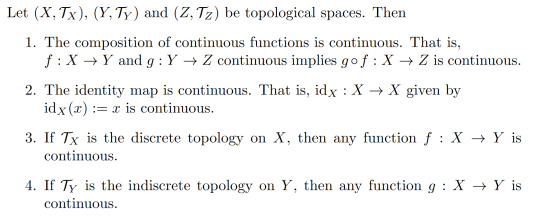
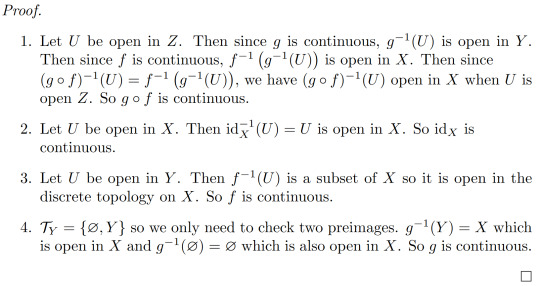
Now we shall define a special kind of continuous map: homeomorphisms. You may have heard of these from pop maths, especially in the context of a coffee mug and a donut being "the same" to a topologist.
Definition 2.6:

Remarks:
Not only are homeomorphisms bijections between the sets, they also induce a bijection between the topologies:

This means that in some sense the topologies on X and Y are the same!
More formally, one can show that ≅ is an equivalence relation on topological spaces. The proof relies on 1) and 2) from Proposition 2.5
Homeomorphisms are in this sense "topological space isomorphisms" since they preserve the important structure of topological spaces: the topology. This is analagous to how bijective linear maps are vector space isomorphisms and how bijective group homomorphisms are group isomorphisms.
Example 2.7:

In fact, we may show any open interval (a,b) is homeomorphic to ℝ by showing that (0,1) is homeomorphic to (a,b) via an affine map then using the fact that "being homeomorphic" is an equivalence relation.
One major goal of topology is to classify topological spaces up to homeomorphism. This is insurmountable if attempted all at once, even if one restricts to special topological spaces, and is still an active area of research. What is a more approachable goal is to find certain properties that topological spaces have which are invariant under homeomorphism. A vast majority of what follows in this series of posts can be seen as a hunt for these invariants whilst also generalising a lot of familiar concepts we have on ℝ with its standard topology.
32 notes
·
View notes
Text
to me, Mamizou and Nue are the type specimen for what I call "youkai married". they clearly have their own spheres of influence and places of residence and agendas, but at the same time are willing to drop what they're doing or move across japan to help the other carry out overly complex schemes, fight the ancient hermit that the other's cult dug up, or engage in what even the most freudian topologist to ever ponder orientable surfaces couldn't interpret as human sex
#yukayuyu are another example but they are also very Human Married and thus less suitable as a type specimen#touhou#maminue
195 notes
·
View notes
Text
quora (a q&a social media site, like yahoo answers, but higher quality) used to have a lot of questions of the form "how would you explain X to your grandmother?" Where X was usually some mathematics or physics concept. Things like:
How would you explain quantum mechanics to your grandma?
Category theory?
General relativity/space-time?
Bayesian statistics?
(this was before quora made it so that you got paid for asking questions that generated engagement, thus inundating the site with troll questions; back then quora had decent questions)
One of my friends, who had a fairly large following on quora, had two grandmothers (out of four, including step-grandmas) who had PhDs in mathematics. He used to love answering these questions like,
"I would say [extremely abstract explanation with analogies to far more esoteric concepts than the question was asking],
But my grandma's an algebraic topologist, so your mileage may vary."
One time some fellow quora users we knew irl asked him about this, since he's generally very sweet and opposed to trolling/being needlessly rude to people online, and someone asked him why he didn't feel bad about ignoring the spirit of the questions, and essentially poking fun at them in front of his large following,
And he said, "well the thing is that these questions are actually kind of rude to grandmas. they act like all grandmas are the same, just some blank slate for you to explain things to, when in fact grandmas can have quite varied interests and knowledge. I'm just responding to the questions' offensiveness in kind"
And then he mentioned how nobody asks "how would you explain [science concept] to your dad?", right?
Because society thinks of fathers as diverse and varied, so why aren't grandmas viewed as a similarly diverse group, when they actually are, and as someone with four grandmas (through divorce and remarriage), he would know (even though two of his grandmas apparently had very similar interests to each other, lol)
.
And I just. Those questions always left a bad taste in my mouth, too, but I had never thought to explain it this way (which I guess is why he was a quora influencer and I wasn't, lol)
I also had more than the normal number of grandmas (grandpa was double married (poly marriage was legal back then)) and like, yeah, each of my three grandmas had a very unique and interesting story.
Two of my grandmas ran away from home to go to university when their families didn't approve of women getting educations. One of these became an electrical engineer.
The other studied law (fully funded on government merit scholarship) and became an understudy to the equivalent of a justice of the supreme court (under the nationalist government, which unfortunately led to her being subject to denunciation rallies later on). She was also into martial arts and knew some gorgeous forms with a sword. (She was the grandma I was closest to because she raised me for a few years when I was a kid)
The other grandma (the one who didn't go to university, grandpa's first wife) was an avid storyteller who could keep all the neighbourhood kids entertained for hours from stories told from memory (her language had no writing system), and also a master at embroidery. She also easily won over my mother and my aunt's love even though they only met her in their early teens (my grandpa had hidden her from their mom, his second wife) and she didn't speak any Chinese, and my mom and aunt only spoke Chinese.
Like, yeah, grandmas are a diverse group and it does suck that society generally doesn't regard them as such
#grandmothers#grandmas#long post#math#physics#diversity of grandmas#for some reason readmore/the keep reading thing isn't working for me atm
110 notes
·
View notes
Video
Teaching myself to sew is recalling my topology education! How do I sew this together inside-out (so that the raw edges are hidden), and then turn it rightside-out to get a functional bag?
I figured out how to do it yesterday--and then forgot, so I had to figure it out again. But this time, I was smart and recorded the solution!
This video is to introduce the problem. I’ll post another one later, with a solution.
---
Where we're at: First, I sewed (essentially) two equally sized rectangles of fabric together to make a cylinder. Now I need to turn the cylinder into something isomorphic to a ball, but where one hemisphere is pressed into the other (to be concave), like a double-walled bowl. I also need the right sides facing out by the end.
A solution I rejected: sew all around the exterior of the fabric, but leave a gap; then pull the fabric rightside-out through the gap. This creates a large rectangle with all edges finished (ie: no raw edges exposed). But then a new problem arises: because the raw edges are hidden, there isn't enough fabric available to make a strong stitch to hold the finished edges togther. So I don't want to use this method.
---
There is an elegant solution that involves three seams (and one gap separating two of those seams).
How did I do it??
---
PS: I’m not posting this to my “shop” blog because I use some self-deprecating language (calling myself a dum-dum) and generally because of its low production value (no rehearsal, poor lighting, I have a cold and didn’t use a mic, etc). Mostly I made this video to share with a Math friend. But then I wondered if other math-and-sewing nerds out there would appreciate it too. So, here we are!
#math#topology#sewing#inside-out#rightside-out#problem statement#topology puzzle#sewing puzzle#hand sewing#hand stitched#project bag#sewing WIP#sewing problems#geometry problem#topology problem#sewists are secretly topologists#maybe math humour#sewing topology
1 note
·
View note